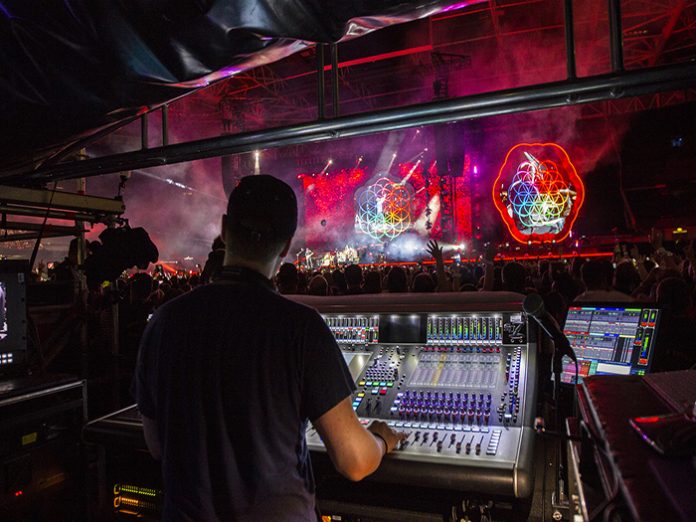Daniel Green has been Coldplay’s FOH engineer and co-producer for almost 20 years with Tony Smith, Audio Desginer, FOH tech and crew chief, racking up 15 years of service and Chris ‘Woodsy’ Wood on monitors 17 years. For Coldplay’s shows, they utilise the DiGiCo SD7 console.
“Live performance is such a big part of Coldplay. When creating new songs, we always consider how they will be performed live,” said Green. “Once the album is nearing completion, I’ll work with each member of the band to develop their sounds and tones for each song. Also, creating ways to perform the songs in a live context.”
The tour, however, is not a reproduction of Coldplay’s studio work. Sounds are changed for certain elements to make ‘live’ tracks. There can be inherent limitations to the sound for arena and stadium shows that just 4 people can make and there is a little bit of what Green refers to as ‘bolstering’, which is where the use of the SD7 comes in.
“We have a regular drum kit of 12 mics or so, but each one of those has triggers for various songs,” Green explained. “For example, there might be an electronic drum sound and, rather than put those beats on track, we want to be able to play them ‘live’. That means we have all the electronic drums as inputs, which is like adding another complete band.”
All of this adds to the input count. The setup is then replicated on a B stage, plus there is an acoustic C stage. “We do as much as we can to combine things,” Green continued, “but we’ve found that by doing that you end up not having the flexibility you need.” Capacity is therefore key – at last count, the channels at FOH ran to 192 going to a Live Pro Tools record – but that’s not the end of the story. The SD7s, supplied along with the rest of the PA by Wigwam Acoustics, have also been chosen for their versatility and their sound quality, with the touring set up comprising an SD7 and SD Rack at FOH, deployed for peripheral outboard kit, and another SD7 with 2 SD Racks at monitors.
“We also have an SD RE with a Nano for additional I/O and an SD10-24 if we need to mirror to them and to have a control surface to work on, but that rarely comes out,” said Smith. “We also have an SD11 for Jack Murphy, PA system tech, to use for time alignment for his peripheral gear, which just makes things easier. Everything is on an Optocore loop, apart from the SD11. It’s the versatility, the I/O and what we can string on to the system that makes the setup work for us. We’re running 2 loops with 4 core fibre, because we’ve maxxed everything out. There are no inputs left on the 2 loops, and just a few outputs. That equates to 128 inputs per band member; we have FOH on one loop and monitors on the second loop.”
Every single note is recorded and used for things like virtual sound checks, live albums and new song demos, with 32 channels of ambient mics negating the need for an OB truck for one-to-one recording. For live broadcasts, stems are sent to an OB truck via the FOH console. “Everything we record gets used, even if the band is just jamming,” Smith added. “We have a ‘crash’ record as well, just in case we lose anything. It’s key to what the band is after and what we need for running up the PA.”
“The bussing infrastructure of the SD7 is amazing,” Green stated. “When we do a live event, I send various stems out to the broadcast truck and the SD7 enables us to dial all that in. And I use a lot of Snapshots; if I find myself doing something more than twice, I’ll make a Snapshot for it. Having a large quantity of faders at my fingertips is also a big thing for me. As much as the Snapshots are important, I like them to be doing things that I don’t want to spend time on, so I can concentrate on mixing the band – that’s what I enjoy most and it makes every show slightly different. It’s exciting for me as well.”
Woodsy used an SD7 quite simply because it can do everything he needs it to do. “I don’t do anything out of the ordinary; the show is big and complicated enough without trying to make it more so,” he said. “But I am using pretty much everything the SD7 has. I’ve got just 6 spare channels of processing, so it’s pretty full. As well as the 3 stages, there’s a shout system with mics all over the place for the crew, which gives me about a dozen inputs. A lot of the crew have Aviom personal monitors, which gives me another 16 outputs just for them. It all adds up. There’s one pair of wedges on stage and some shakers, everything else is all in ears. The whole system is reliant on networking. Ali Viles, our RF tech, has 2 systems, so what I send out of the monitor consoles goes to both of our 2 Racks separately and to 2 separate in-ear transmitters, so there’s an element of redundancy.”
“The support we get from DiGiCo is also really important,” Smith concluded. “The whole package is great and works so well for us. And, as we keep getting great reports from the band, promoters and venues, I think we’ve got it nailed!”






